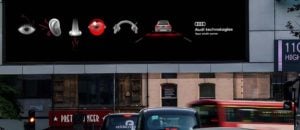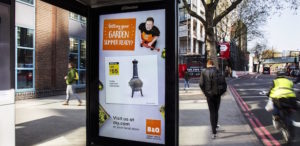

3 Reasons to Have Your Out of Home Campaign Data Driven
Out of home (OOH) advertising is one of the oldest, yet most effective and profitable methods of advertising your business. Reasons for this are as follows according to Air Out Door:
- 71% of consumers view messages on roadside billboards.
- Bus shelter ads reach 92% of the US population weekly.
- Billboard marketing costs 80% less than television advertising.
- Almost 26% of customers have visited a website in response to OOH adverts.
- OOH ads are able to drive a 38% increase in mobile engagements with brands.
According to WARC, the global out of home ad-spend is forecast to increase 3.2% in 2018 to 34 billion dollars, driven by an increase in digital OOH; and as one of the oldest forms of advertising, OOH is undergoing a vast revolution as digital formats grow and become more targeted.
Smart phones have now given advertisers a means of interacting with consumers via DOOH, placing data driven campaigns in the spotlight which can drive your initiative beyond how many people are passing a site.
Lets dive into the top 3 reasons why!
1. Build Your Brand and Drive Sales
 Brands are in constant competition in getting consumer attention. There are two distinct trends within our current market. The first trend is where the Out of Home activity has been planned to strengthen an already present social media campaign; the second trend is where social media is used to emphasize the digital out home movement.
Brands are in constant competition in getting consumer attention. There are two distinct trends within our current market. The first trend is where the Out of Home activity has been planned to strengthen an already present social media campaign; the second trend is where social media is used to emphasize the digital out home movement.
Studies convey that full-motion Out of Home can extend the reach of a TV campaign effectively by contributing to positive brand-building outside the home. When a message is relevant in the moment and contextually delivered, consumers are more receptive. And this is especially true when allowing brands to engage with consumers, from interactive experience to ‘bespoke’ messaging.
OOH as a brand builder has been apparent since the birth of modern day billboard advertising via the invention of lithography in the 1970's. Its 98% reach of the UK population distinctively positions this channel to grasp the attention of a broad range of customers. Bus shelter adverts reach 92% of the population every week, and after TV Out of Home delivers the second-best sales ROI out of traditional media.
However, with the advent of DOOH and data driven marketing, marketers have the opportunity to engage customers with tactile, experiential and interactive experiences.
 For example, Audi unveiled a DOOH campaign on using API’s and public data to present their digital ads on roadside displays to promote real-time driving conditions, measuring the present driving conditions such as time, weather and traffic to boost the diverse characteristics of their driving technology. This movement has now been successful in 9 cities in the UK and has been viewed on 211 screens reading the tagline “Audi as your sixth sense.”
For example, Audi unveiled a DOOH campaign on using API’s and public data to present their digital ads on roadside displays to promote real-time driving conditions, measuring the present driving conditions such as time, weather and traffic to boost the diverse characteristics of their driving technology. This movement has now been successful in 9 cities in the UK and has been viewed on 211 screens reading the tagline “Audi as your sixth sense.”
Chief Creative Technology Officer at Grand Visual, Dan Dawson, states, “Clever use of data and technology amplifies campaign relevance, transforming digital out-of-home advertising networks into real-time marketing platforms. With the right team and a collaborative approach, it’s never been easier to produce engaging and responsive campaigns at an individual screen level ensuring the campaigns remain targeted and relevant.”
2. Local Messaging
 This is a great tool in promoting their business effectively to those that are local to the area in which the brand is being advertised. Survey results from OCS shows that 74% of those asked, said that they were most engaged by advertising messages that are relevant to their location.
This is a great tool in promoting their business effectively to those that are local to the area in which the brand is being advertised. Survey results from OCS shows that 74% of those asked, said that they were most engaged by advertising messages that are relevant to their location.
Growth of smaller DOOH set ups in shopping malls, high streets, airports and transport hubs allow for more proximity or location-specific instigation's. An example of this is B&Q; this brand uses different ads depending on the local weather. They have high street ads running which are powered by weather data they collect, pushing specific products dependant on the current climate. Using OOH advertisements in this way will have a better chance in reaching potential customer needs.
3. Measurable - Outdoor Effectiveness
When measuring the effectiveness of outdoor advertising, numerous diverse aspects need to be taken into account, as there are two main things to consider with poster and billboard advertising. You will need to question yourself on:
- What is the potential audience size for your displays?
- How many of those individuals from that potential audience viewed your ad?
Then from that, it is important to ask yourself:
- How many of those that viewed your ads have engaged with your brand?
- Has there been a positive effect on sales?
The measurement of outdoor effectiveness can be broken down into 2 elements. Firstly, opportunity to contact. Esomar, the market research company, uses the term Opportunity to Contact (OTC) as a metric for gauging how many individuals will possibly walk past your advert and view it. Similarly, Visibility Adjusted Contact (VAC) is regarding the actual number of people that view the billboard ad.
Secondly, mobility, which is a measurement of any movement; be it journey on foot or by vehicle taken between various points in the outdoor environment. This monitors the movement from potential consumers through use of GPS, allowing a more accurate understanding of how people view OOH. With location data enabled, brands can survey people walking past a billboard.
And lastly, traffic data, which consists of a measurement of vehicle traffic or pedestrians through a specific road section relating to the advertising site.
[video loop="true" width="1920" height="1080" mp4="/wp-content/uploads/2018/09/Diageo_Captain_Morgan.mp4"][/video]
An OOH campaign that ICP created for Captain Morgan at Clubhouse St. Pauli in Hamburg, Germany.
Certain trends are already having a huge difference on how OOH is reaching its audience. Following these steps correctly will ensure a better response, more effectiveness and a stronger delivery for your future OOH campaigns.





%E2%80%8B%20%E2%80%8B.png?length=256&name=Blue%20B__Implement-%20(Technology%20Implementation)%E2%80%8B%20%E2%80%8B.png)
%E2%80%8B%20%E2%80%8B.png?length=256&name=__Implement-%20(Technology%20Implementation)%E2%80%8B%20%E2%80%8B.png)
%E2%80%8B.png?length=256&name=Blue%20B__Adopt-%20(Technology%20Adoption)%E2%80%8B.png)
%E2%80%8B.png?length=256&name=__Adopt-%20(Technology%20Adoption)%E2%80%8B.png)






%E2%80%8B-%E2%80%8B%20%E2%80%8B.png?length=256&name=Blue%20B__Align%20(Content%20Alignment)%E2%80%8B-%E2%80%8B%20%E2%80%8B.png)
%E2%80%8B-%E2%80%8B%20%E2%80%8B-1.png?length=256&name=__Align%20(Content%20Alignment)%E2%80%8B-%E2%80%8B%20%E2%80%8B-1.png)
.png?length=256&name=Blue%20B__Activate%20(Content%20Activation).png)
-1.png?length=256&name=__Activate%20(Content%20Activation)-1.png)


















